We have much more to do and your continued support is needed now more than ever.
Expert Tips for Attracting Hummingbirds and Orioles
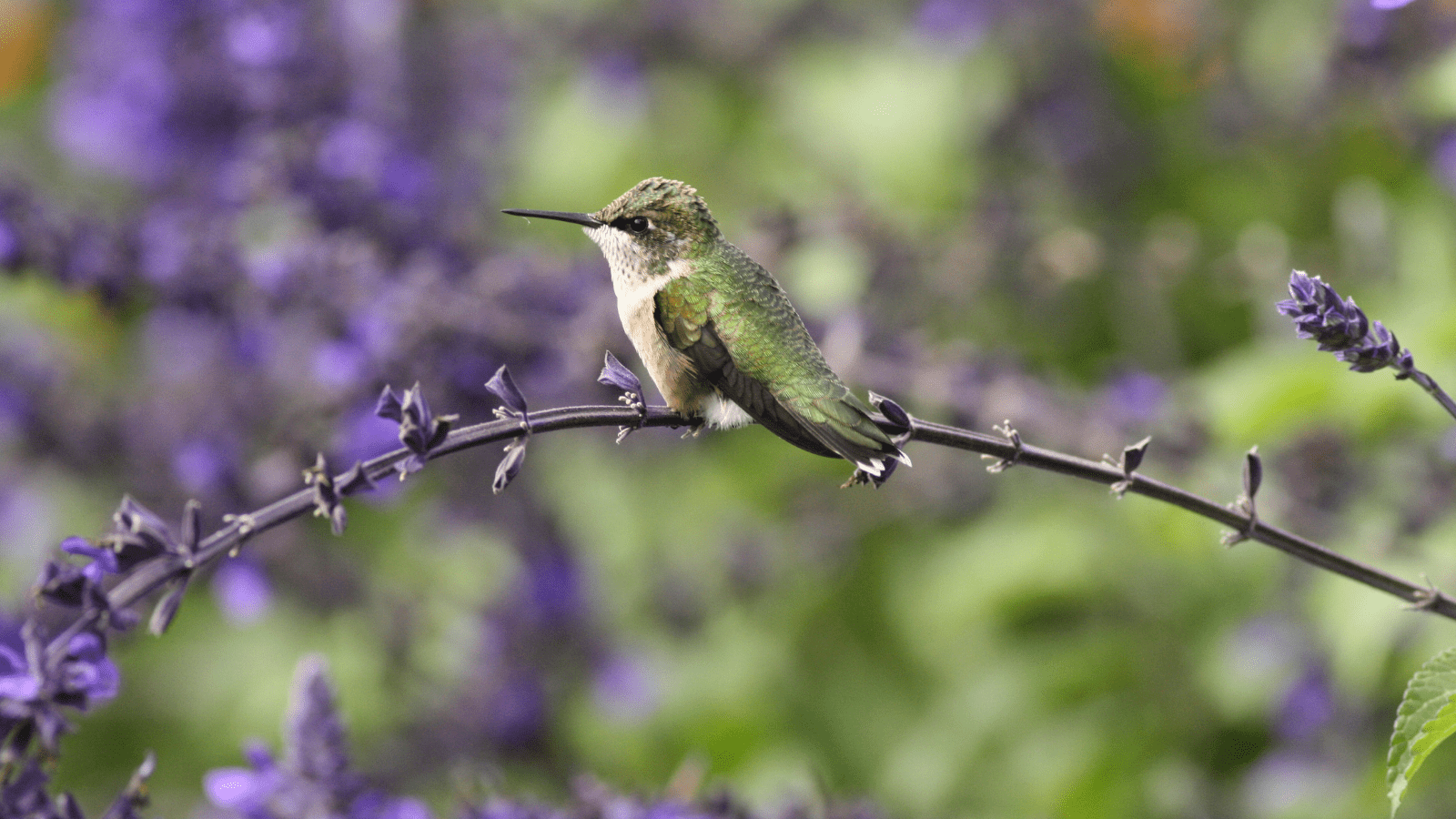
We asked the folks at Wild Birds Unlimited, the National Wildlife Federation’s “Certified Wildlife Habitat Champion” partner helping to promote our Garden for Wildlife movement, for their best tips on attracting hummingbirds and orioles to your yard or garden. Here’s what they had to say:
What are your tips for attracting hummingbirds and/or orioles?
Hal Smith, owner of the Wild Birds Unlimited in Auburn, AL:
Ruby-throated hummingbirds begin migrating through in mid-March and will stay with us until mid-October. The best way to attract them to our yards is to provide native plants with tubular-shaped flowers. These include trumpet vine, coral honeysuckle, cardinal flower, and bee balm.

Any nectar-producing flowers can attract insects which will attract hummingbirds. Nectar feeders can provide good nutrition for the hummingbirds and can get them up where we can see them better. We also recommend water misters to provide water and a bath for the hummingbirds.
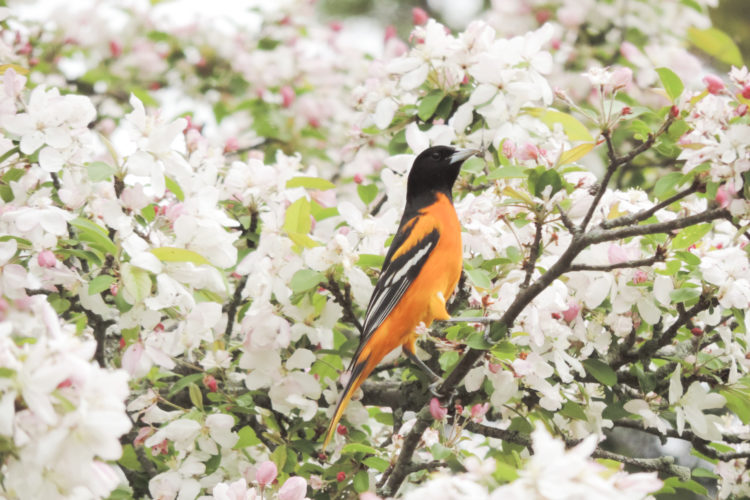
Baltimore orioles tend to migrate through our area and not hang around. Some people put out nectar feeders, orange halves, and grape jelly to try and attract Baltimore orioles to their yards. To get a glance as they pass through our area, a look at the tops of tulip poplar trees can reward people here with a view of Baltimore orioles and orchard orioles and warblers and tanagers. I think they are attracted to the nectar and to the insects in the yellow and white flowers.
What are the best native plants to attract hummingbirds and/or orioles in your region?

Rosann Kovalcik, owner of the Wild Birds Unlimited in Grosse Pointe Woods, MI:
Hummingbirds need a source of nectar from their arrival in May through their departure in August. Native plants are the best offering as they produce more nectar than other plants and they also attract the insects that hummingbirds will eat, with insects being the other major part of their diet.
Suggested native flowers for continual nectar in our area:
- Aquilegia canadensis (columbine) blooming April and May,
- Phlox divaracata (woodland phlox) blooming May and June,
- Geranium maculatum (wild geranium) blooming May through June,
- Penstemon digitalis (foxglove beardtongue) blooming June & July,
- Liatris Spicata (blazing star) blooming July through September
- Monarda didyma (bee balm) blooming July through August
- Lobelia cardinalis (cardinal flower) blooming July through September
Planting in masses with each of these flowers is most likely to get the attention of a hummingbird flying over your yard. All of these plants have been field-tested by me in my personal gardens and they “behave well”, not spreading or looking too messy for someone used to non-native flowers.
When orioles first return to the area for breeding, they are looking for blossoms that will yield them nectar and as a side benefit, the insects that would be at those flowers. Amelanchier (serviceberry species) would be the favored choice as it blooms earliest.
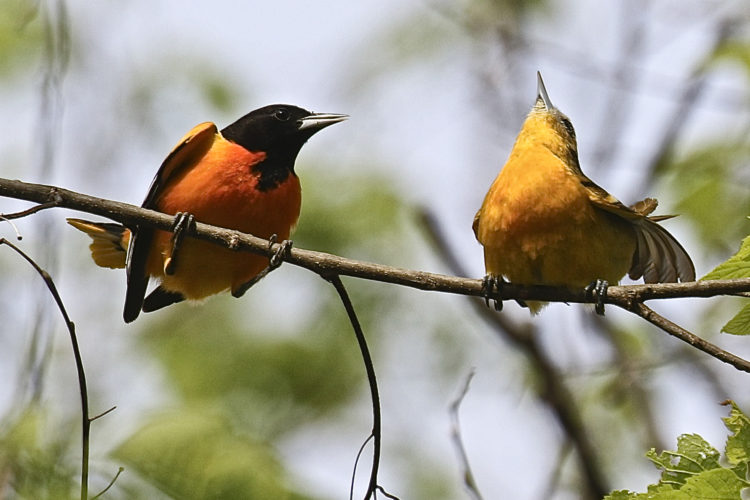
Any of the trees and shrubs that provide dark fruits are the preferred food of Orioles including:
- Prunus serotina (black cherry)
- Prunus virginiana (chokecherry)
- Vaccinium angustifolium (lowbush blueberry)
- Vaccinium corymbosum (high bush blueberry)
Keep in mind that orioles are also searching for insects as a protein source. The best sources for caterpillars include Quercus (oak species), Prunus (cherry species), Betula (birch species) and Salix (willow species). These four species alone are host plant for more caterpillars than any other combination.
Valerie Sinex, owner of the Wild Birds Unlimited in Yorba Linda, CA:
Our year-round Anna’s and Allen’s hummingbirds love native tubular flowers like penstemons, salvias and fuchsias. Snapdragons, monkey flowers, and western columbines are favored as well. Agaves and yuccas attract hummingbirds and hooded and Bullock’s orioles to their flowering stems, so they’re great to have in the mix.
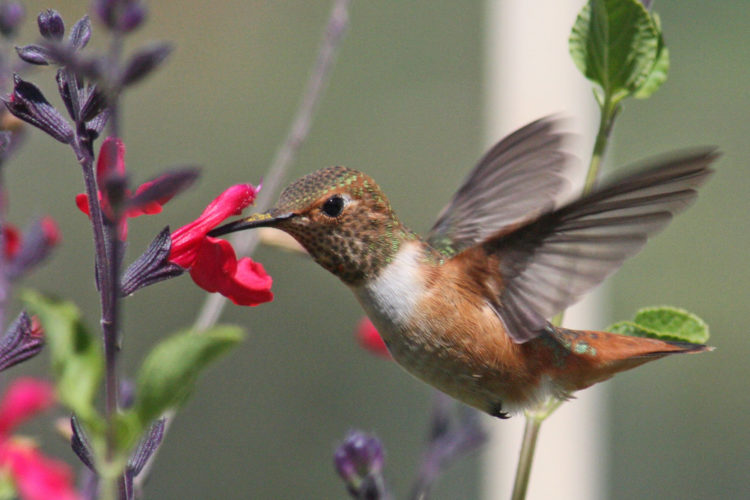
Plant native milkweed for butterflies and watch orioles incorporate the stems into their pendulous nests, which typically hang from native California fan palms (Washingtonia filifera).
A tip for choosing native shrubs is to remember the three Rs. Plants in the Rhamnus, Rhus and Ribes genera attract hummingbirds and bees with their flowers and—BONUS—draw in visiting hooded and Bullock’s orioles with their berries. (American robins, western bluebirds, cedar waxwings, California scrub jays and northern mockingbirds all love the berries, too.)
How do I encourage hummingbirds and/or orioles to nest?
Rosann Kovalcik, owner of the Wild Birds Unlimited in Grosse Pointe Woods, MI:
Spider webs are critical to nest construction for hummingbirds; therefore, spraying any pesticides would eliminate that element. Hummingbirds use downy plant material for their nests, such as the parts of Osmunda cinnamomea (Cinnamon fern), Salix discolor (pussy willow) as well as moss and lichens. A container planted with mosses is a good alternative.

Orioles need long fiber strands in order to create their nests. I have witnessed female orioles at the base of milkweed plants that have been left to over-winter, clipping the bottom and pulling back to create a strand of workable material. Hyssop species and native grasses would all work well for this purpose. Orioles nest in large trees that have hanging branches as opposed to horizontal ones. Maples, cottonwoods, and elms are all good choices to provide for nesting trees.
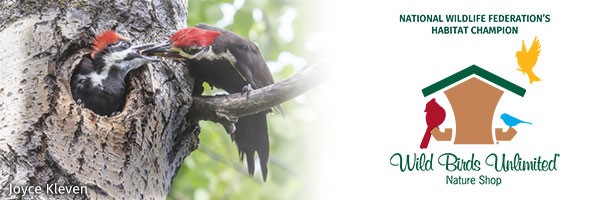
What should I look for in a hummingbird and/or oriole feeder?
Kecia Cole, co-owner of the Wild Birds Unlimited stores in Gig Harbor and Puyallup, WA:
When I’m looking at a hummingbird feeder I’m looking for a feeder that’s practical—easy to use and easy to clean (no one wants to spend hours trying to clean a feeder!). I love the pretty glass ones, but they are hard to keep clean so I’ve learned the hard way to stay away from those. Bottle shape ones might also look nice, but they leak.
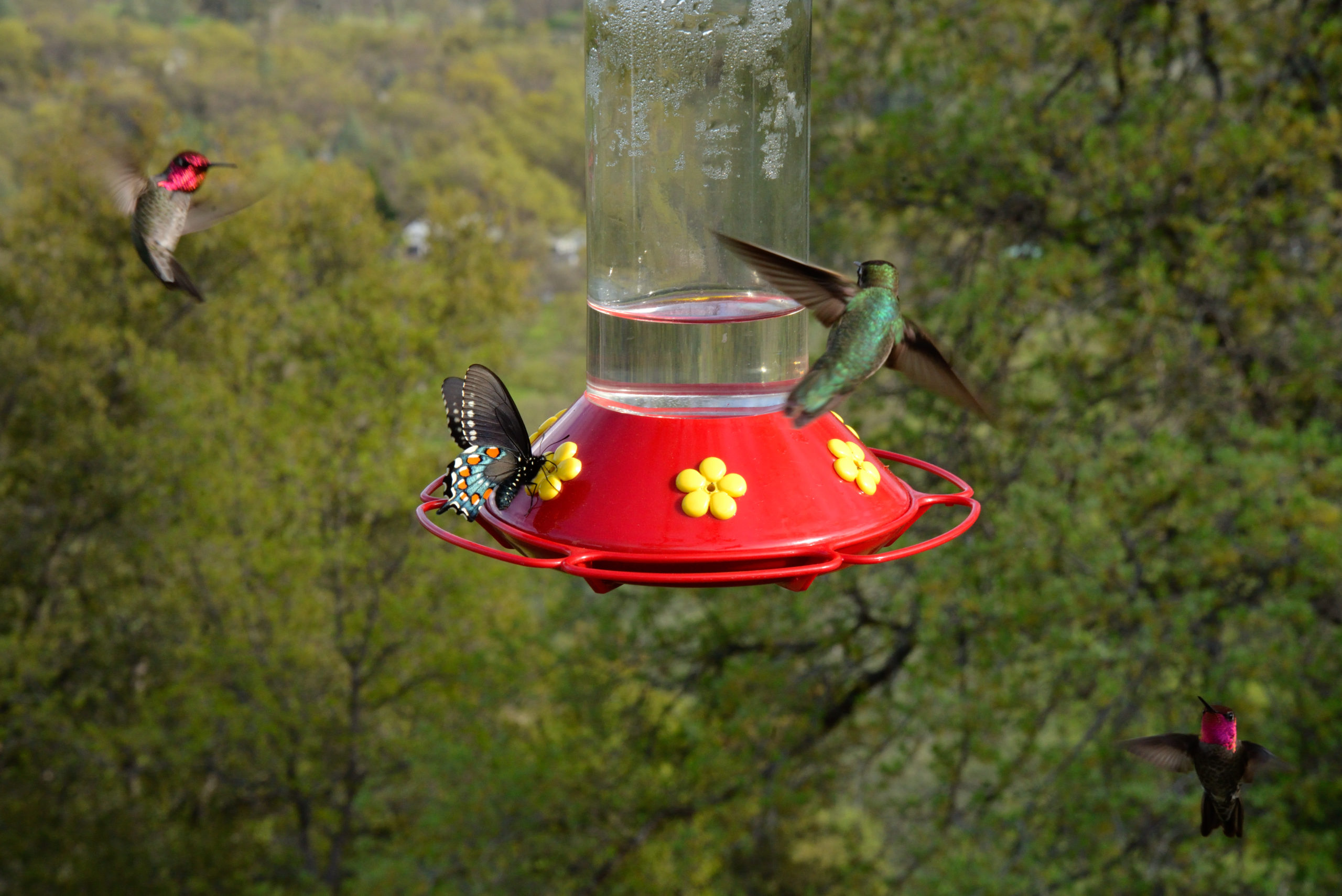
I need to be able to easily take the feeder apart for cleaning and reach all of the areas with a scrub brush to make sure that the feeder is kept clean. I stay away from feeders that bees can reach the nectar, if they can’t get to it they will leave the feeders alone. I like to have multiple smaller feeders that I can scatter throughout my yard since hummingbirds have a tendency to not share and since they don’t hold a ton of nectar, it forces me to clean and refill them on a regular basis to ensure that I keep everything safe for my favorite hummingbirds!
Tamar Boorstin, owner of the Wild Birds Unlimited in Palm Coast, FL:
Some key features you want to look for in a great hummingbird/oriole feeder would include:
- Visibility: Can you see and enjoy the birds? Taller, vertical or more cylindrical style feeders may obscure or hide the birds on the opposite side of the feeder. A dish-style feeder allows the birds to hover over or perch on the feeder, which will allow you a longer and clearer 360-degree view of the birds.
- Is it leak-proof? Feeders tend to sway or blow in the wind, which may cause the nectar liquid to drop or spill out. Some hummingbird feeders with flower tips may also allow drips. Drips cause ants and sometimes a sticky mess below. Look for a feeder with a wider base or flat, dish style feeder that will likely cause less drips if they sway.

- Does it have an ant moat? Ants can be a big problem if they can get to the sweet nectar inside a hummingbird/oriole feeder. Look for a feeder with a built-in ant moat, which you fill with water, to trap the ants before they reach the nectar. You can also purchase ant moats with a hook at the bottom to hang the feeder beneath it, typically.
- Easy to clean? One of the main reasons we hear that people stop feeding the hummingbirds or orioles is that the feeder was too difficult to clean or had too many small parts. Look for an easy-to-clean feeder. The less parts and nooks and crannies, the better! Many of our Wild Birds Unlimited hummingbird feeders are dishwasher safe (top rack).
How do I keep my hummingbird and/or oriole feeder clean?
Kecia Cole, co-owner of the Wild Birds Unlimited stores in Gig Harbor and Puyallup, WA:
Regular cleaning is essential to maintaining a safe feeding station for hummingbirds. Hot water, white vinegar, a good bottle brush, and a nectar port brush are the best tools of the trade. White Vinegar is especially helpful because it kills bacteria, helps to dissolve & loosen gunk but it’s safe for both you, the birds, and the environment.
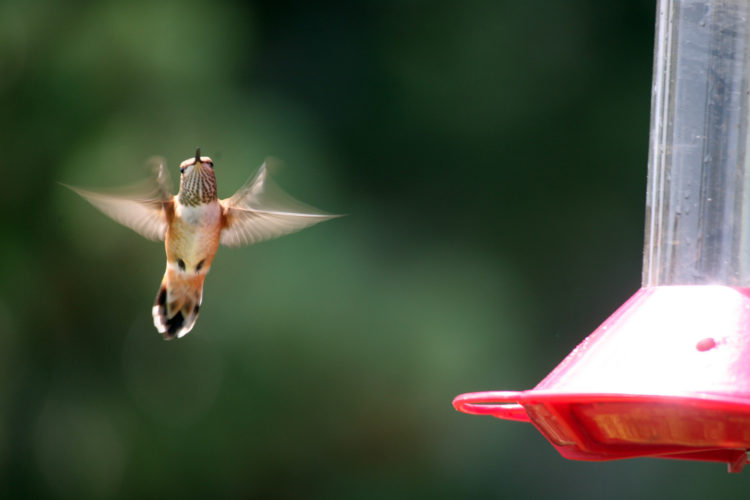
Bleach of course works, but if you don’t rinse the feeders completely it can be very harmful to the birds. A few minutes of regular cleaning can prevent mold and bacteria growth and keep our hummingbird feeders clean and safe. I love to have a clean feeder ready to be filled so that I can take the fresh feeder out and swap it with the empty feeder, which keeps the hummers happy and gives me time to clean the empty feeder so that it’s ready to go for the next time!
Tamar Boorstin, owner of the Wild Birds Unlimited in Palm Coast, FL.
You really need to be sure to keep your hummingbird/oriole feeders clean for the safety of the birds. Sugar nectar sitting out in the hot sun can cause mold or mildew to build up and the nectar will go bad and be unsafe for the birds. Depending where you live, the warmer the weather, the more often you need to change out and clean the feeder.

Here in Florida, we advise every 2 days or so if it’s hot. Wipe out the feeder and use warm water and Dawn dish detergent OR vinegar to clean the feeder, inside and out. Use small port brushes to clean inside any small holes or tubes. If the feeder is dishwasher safe, go ahead and put it in the top rack.
Why does Wild Birds Unlimited with its bird focus care about pollinators such as bees and butterflies?
Valerie Sinex, owner of the Wild Birds Unlimited in Yorba Linda, CA:
Wild Birds Unlimited has always encouraged people to discover refuge in their outdoor space. Creating or restoring habitat with native plants—whether on a patio or balcony, in a yard, school, or community plot–can create that refuge for birds, bees, butterflies, and for people!
Everything in our world is knit together. Growing native buckwheat as a host plant for butterflies will also provide nectar for bees and hummingbirds, leaves and seeds for finches, towhees, and quail, and shelter for other creatures all at the same time. A good environment for birds benefits other wildlife species which need support. Even simple actions can have a positive impact on an entire ecosystem.






















